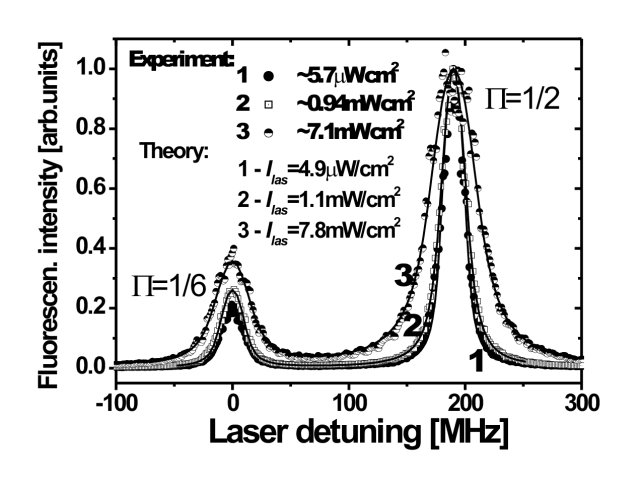Optical pumping (OP) in open level systems can lead to curios effects on
lineshapes at laser intensities well below the saturation limit. If
a two-level system interacts with near-resonant photons, the ground
state g is radiatively broadened, with the width
 given by [1]
given by [1]
 ,
,
where
 is the natural width of the excited state e,
is the natural width of the excited state e,
 is the detuning from the line centre, and
is the detuning from the line centre, and
 is the Rabi frequency. The width
is the Rabi frequency. The width
 is equal with the rate of the spontaneously emitted photons. In the
case of an open level system, only a fraction
is equal with the rate of the spontaneously emitted photons. In the
case of an open level system, only a fraction
 of the spontaneous transitions returns population to the initial
state g, while the fraction
of the spontaneous transitions returns population to the initial
state g, while the fraction
 leaves the (g,e)-system. The rate
leaves the (g,e)-system. The rate
 of such pumping is obviously
of such pumping is obviously
 ,
and the corresponding pumping time is
,
and the corresponding pumping time is
 .
.
Depletion of the system will be remarkable for Rabi
frequencies, which ensure that pumping time is shorter than transit
time  of atoms through the laser field. The critical value of Rabi
frequency is given by
of atoms through the laser field. The critical value of Rabi
frequency is given by
 ,
where Ωsat is the saturation Rabi frequency [2]. In terms of laser intensities
it can be rewritten as
,
where Ωsat is the saturation Rabi frequency [2]. In terms of laser intensities
it can be rewritten as
 .
.
The above equation implies that the critical laser intensity Icr
has a minimum when
 =0.5.
Hence, the nonlinear effects are more pronounced for transitions
with branching coefficients
=0.5.
Hence, the nonlinear effects are more pronounced for transitions
with branching coefficients
 close to 0.5.
close to 0.5.
Broadening by optical pumping can be demonstrated, for example, by laser excitation of the 3s1/2(F"=1) → 3p1/2(F'=1,2) transition in a supersonic beam of Na atoms, under the conditions when transit time τtr=2700 ns is much larger than the natural lifetime τnat=16.4 ns of the 3p state. In that case, Icr << Isat, therefore broadening and saturation of HF components in the excitation spectrum should occur at laser intensities well below the saturation intensity. This is confirmed by the experiment (see Fig. 1). Significant broadening of spectral lines in the excitation spectrum is observed well below the saturation intensities (Isat = 37.4 and 12.5 mW/cm2 for lhs and rhs components, respectively). The studies also showed that that presence of dark (i.e., not laser- coupled) Zeeeman sublevels in the lower state results in effective branching coefficients which vary with laser intensity and differ from those implied by the sum rules, and this can lead to peculiar changes in peak ratios of hyperfine components of the spectra. These results are published in [3].
